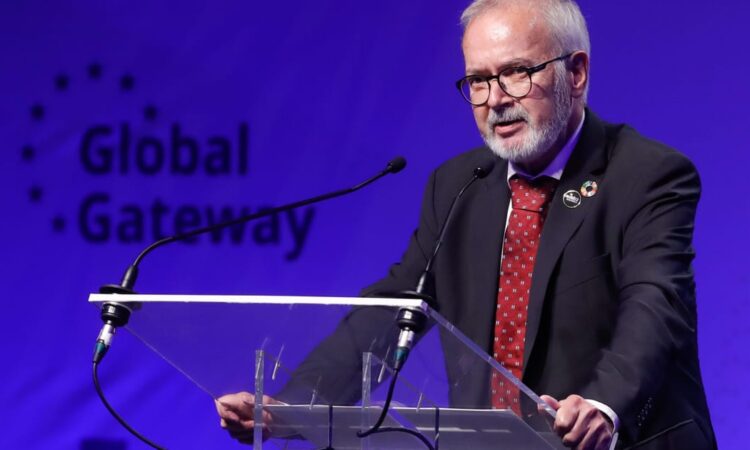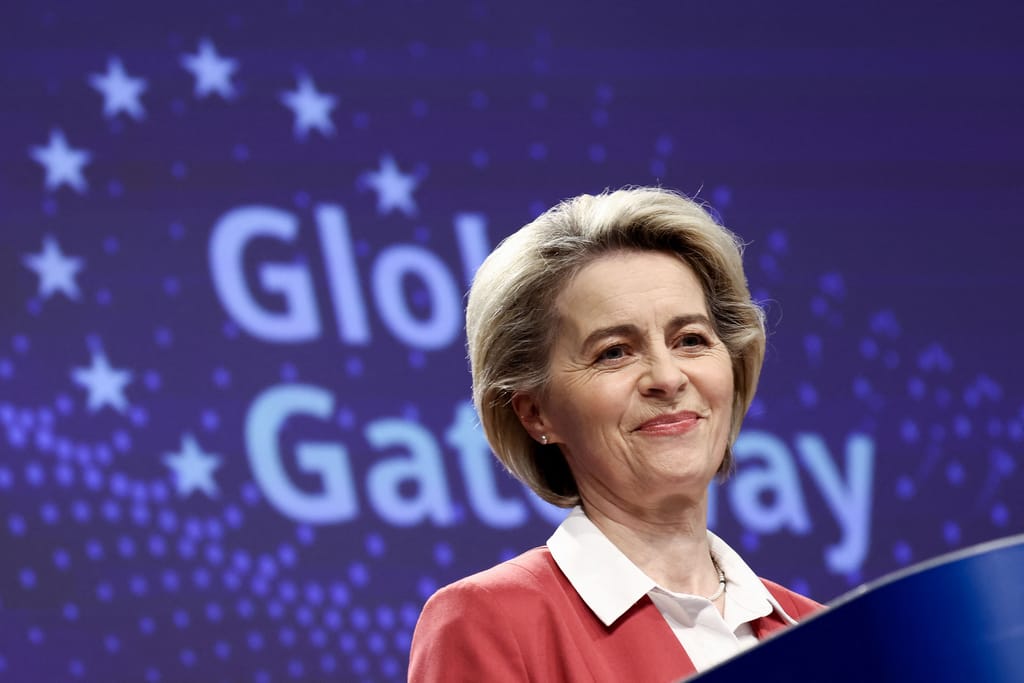
Press play to listen to this article
Voiced by artificial intelligence.
David McAllister is the Chair of the Foreign Affairs Committee in the European Parliament.
On Wednesday, many are assembling in Brussels for the first Global Gateway Forum — a platform for global stakeholders, such as governments, financial institutions, the private sector, civil society and international organizations, to expedite the European Union’s Global Gateway projects.
In today’s globalized world, transregional infrastructure projects have become an integral part of international relations. And as we face an estimated €13 billion shortage to meet the U.N.’s development goals for 2024, China has penetrated this worldwide financing gap with targeted offers, creating a sphere of dependency that reaches as far as Europe.
By March 2022, 147 countries — including 18 EU members — had already signed Memorandums of Understanding with China to become part of its Belt and Road Initiative (BRI). Backed by unrivaled financial muscle, this strategy has since been increasing Beijing’s presence and influence on the world stage. And in the face of China’s growing influence, it’s no longer enough to make a verbal case for our rules-based democratic model.
The EU now needs to practically demonstrate to partner countries that it can make better offers than China — transparently and without debt traps
This is precisely the purpose of the Global Gateway initiative, which European Commission President Ursula von der Leyen launched in 2021. This isn’t a piece of legislation, an instrument or a policy in itself — it’s a strategic framework designed to streamline the EU’s external investment and development cooperation projects with partner countries, ensuring that efforts aren’t scattered or diluted.
With partnerships like these, the EU wants to gain international influence. The idea is for the Commission, member countries and the private sector to join forces as “Team Europe,” and mobilize €300 billion in funds to boost smart, clean and secure links across the world’s digital, energy and transport systems. This holistic approach to development also implies that specific infrastructure projects will be accompanied by a broader package — including regulatory and administrative support, improved standards and long-term maintenance.
Whether in the form of dams, motorways or railway lines, with the BRI, China has so far created targeted offers in a quick and seemingly attractive manner. The Chinese head of state and Communist Party leader Xi Jinping can order investments worth billions by decree. Despite — or perhaps due to — their quick implementation, however, these Beijing-sponsored projects often entail environmental damage and expensive borrowing. In fact, recent studies reveal that 60 percent of Chinese foreign loans face default risks. “Coming to a rescue,” Beijing has dramatically expanded emergency lending, while channeling bailout funds to countries with low foreign exchange reserve levels and weak sovereign credit ratings. It also pairs emergency rescue loans with an average interest rate of 5 percent. By comparison, the International Monetary Fund’s average rate for rescue loans is 2 percent.
This combination of infrastructure investment and rigorous interest politics has now started causing growing mistrust in the Global South, and emblematic of this is the Coca Codo Sinclair dam in Ecuador. Considered a triumph of Chinese engineering, this gray colossus was supposed to transform Ecuador into an exporter of green electricity. But since its inauguration in 2016, there has only been trouble. Cracks run through the concrete, repairs are needed constantly, and the Ecuadorian judiciary is dealing with bribe payments. Meanwhile, downstream, the Rio Coca is silting up and the San Rafael waterfall is withering away.
And because this exemplifies the dark side of the BRI, it’s important to note that it was the Chinese company Sinohydro that built the dam in the first place, following a nontransparent tender procedure — much to the frustration of Ecuadorian civil society. So, it seems China’s relatively indiscriminate labeling of numerous state investment projects abroad as “Belt and Road” is starting to take its toll.
The EU can’t afford to squander this moment. The Global Gateway was stuck in the bureaucratic loops of the Commission for too long. And now, contours of a strategic approach are finally starting to emerge, with the EU listing concrete intermediate steps for a total of 87 flagship projects for the first time this year.
Here, the “Medusa” data cable warrants particular attention. Work on this project commenced this July, with the European Investment Bank and the Commission contributing financially. The idea behind it is to link 500 universities and research institutes in Morocco, Algeria, Tunisia and Egypt with those in Portugal, Spain, France, Italy and Cyprus via a 7,100-kilometer fiber-optic cable. Up to 99 percent of the world’s digital communications run on such submarine cables; without them, there would be no video conferencing, no research cooperation, no Netflix. Therefore, they are not only of high economic value but also of strategic value.

Another high-profile example is the BELLA II initiative, an extension of the successful BELLA I program. Expanding the submarine cable linking Europe and Latin America by connecting more countries to the BELLA infrastructure, it aims to expand the digital landscape of Latin America and the Caribbean, while promoting knowledge-sharing and cooperation in research, innovation and education with the EU.
But to match this political commitment and geopolitical ambition, well-defined private sector engagement is key. Thus, the impending Global Gateway Forum is a valuable opportunity to provide some much-needed clarity on the initiative’s governance structure, as well as how the private sector’s firepower can be mobilized and leveraged. Without this, partners will lack a clear idea of how the Global Gateway functions and how they can participate in it. Public funds alone won’t be able to generate the investment needed. Therefore, convincing European companies and mobilizing private capital will be an important challenge going forward.
For the next couple days, three questions should thus be guiding the EU’s dialogue with its interlocutors — be they public or private: What makes an offer high quality for our partner countries? Does the project help prevent the influence of authoritarian countries in EU members and EU partner countries? And how long will it take for a specific project to be realized?
There’s no doubt it will take time, patience and sustained political will to develop the Global Gateway into a success — which is all the more reason the EU should use the current momentum to fulfill its promise of a sustainable and fair offer to its partners. And as China’s BRI takes its toll, the bloc needs to recognize the signs of the time and demonstrate its commitment to equitable, sustainable and transparent infrastructure alternatives.
If not now, when?





